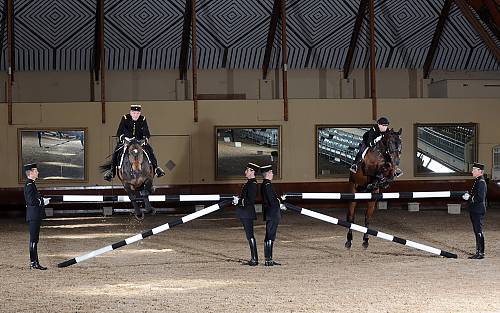Equitation in the French tradition
Inscribed in 2011 (6.COM) on the Representative List of the Intangible Cultural Heritage of Humanity
Country(ies): France
Identification
Description

- Equitation in the French tradition
- © ENE/Alain Laurioux, 2009
Equitation in the French tradition is a school of horseback riding that emphasizes harmonious relations between humans and horses. The fundamental horse-training principles and processes are guided by non-violence and lack of constraint, blending human demands with respect for the horse’s body and mood. Knowledge of the animal itself (physiology, psychology, anatomy) and human nature (emotions and the body) , are complemented by a horseman’s state of mind that combines skill and respect for the horse. Fluidity of movements and flexibility of joints ensure that the horse participates in the exercises without coercion. Although practised throughout France and elsewhere, the most widely known community is the Cadre Noir of Saumur, based at the National School of Equitation. The common denominator among riders is the desire to establish close relations with the horse, build mutual respect and work towards achieving ‘lightness’. Cooperation between generations is strong, with respect for the experience of older riders, galvanized by the enthusiasm of younger riders. The Saumur region is also home to instructors, horse breeders, craftspeople (saddlers, boot-makers), veterinary services and blacksmiths. Frequent public displays and galas hosted by the Cadre Noir of Saumur help to sustain the visibility of equitation in the French tradition.
Documents
- Nomination form: English|French
- Consent of communities: French
- ICH inventory - Annexe : Fiche type d’inventaire national: French
Decision 6.COM 13.14
The Committee (…) decides that [this element] satisfies the criteria for inscription on the Representative List of the Intangible Cultural Heritage of Humanity, as follows:
- R.1: French equitation entails knowledge and skills of horse riding, transmitted from generation to generation and recognized by the community of horse riders as part of its cultural heritage;
- R.2: Its inscription on the Representative List could enhance visibility and awareness of the significance of the intangible cultural heritage particularly among practitioners of similar traditions elsewhere;
- R.3: Current and planned measures to safeguard French equitation include scientific research, gala and public displays, world tours of the Cadre Noir and awareness raising;
- R.4: The nomination was elaborated with participation of the equitation community and contains evidence of the free, prior and informed consent of the riding masters of the Cadre Noir;
- R.5: Equitation in the French tradition: the Cadre Noir of Saumur is included in the inventory of intangible cultural heritage of France, maintained by the Ministry of Culture and Communication.
Inscribes Equitation in the French tradition on the Representative List of the Intangible Cultural Heritage of Humanity.
Slideshow
Video
© 2009 Ecole Nationale d’Equitation
These videos (and many more) can also be consulted through the UNESCO Archives Multimedia website











